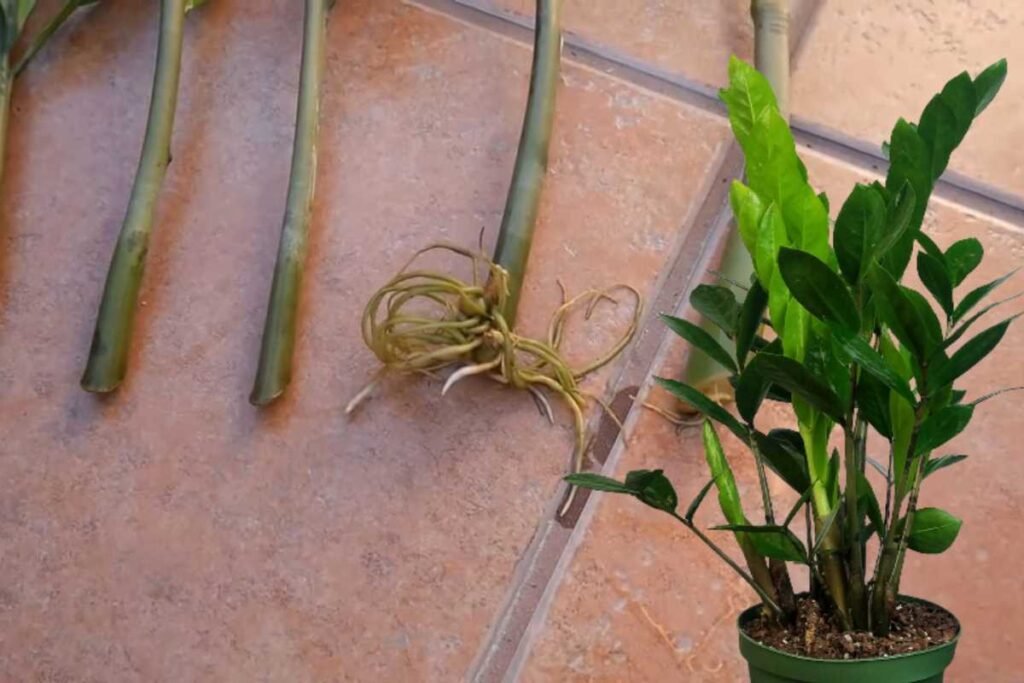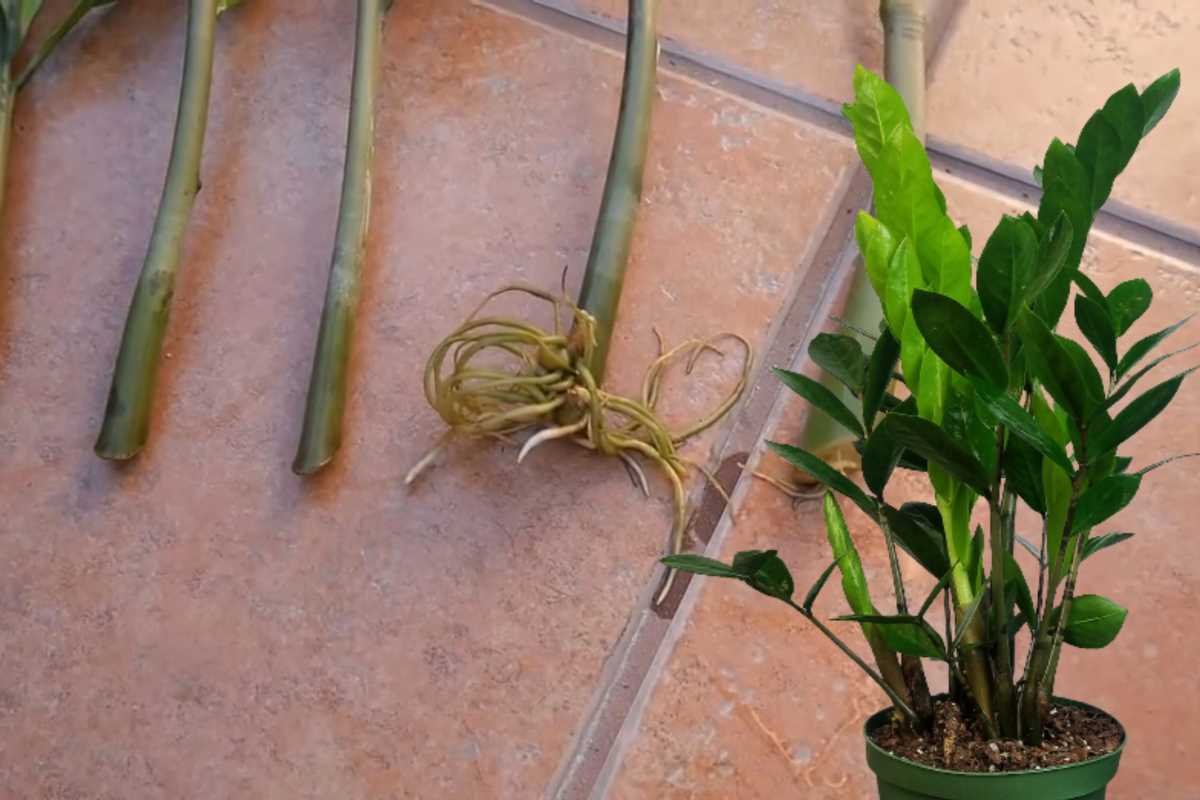Growing ZZ plants from cuttings are not as difficult as it may sound. Even novice gardeners can successfully propagate their own plants at home.
The ZZ plant (Zamioculcas zamiifolia, Zanzibar Gem, Zee Zee plant) is a hardy, easy-to-care-for houseplant that’s popular among both experienced and beginning gardeners alike.
It’s native to East Africa, where it grows in dry climates, and it’s known for its ability to survive in low light and hot or cold temperatures.
What is plant cutting?
Plant cuttings are pieces of stem or leaves that are cut from a parent plant and used to propagate new plants.
Cuttings can be taken from both herbaceous and woody plants, and each type of plant has its own preferred method of propagation.
For example, herbaceous plants such as impatiens and coleus can be propagated from stem cuttings, while woody plants such as azaleas and rhododendrons are best propagated from leaf cuttings.
To take a cutting, gardeners simply use a sharp knife or pair of scissors to remove a section of stem or leave it from the parent plant.
The cutting is then placed in a potting mix and given bottom heat to encourage rooting. Once the cutting has rooted and started to grow, it can be transplanted into its own pot or planted in the garden.
By taking cuttings, gardeners can easily propagate their favorite plants without having to purchase new seedlings or starts.

How to grow ZZ plant from cutting?
To start growing your own ZZ plant using cuttings, you’ll need a few basic supplies: a sharp knife or razor blade, potting soil, sand or perlite, scissors or pruners, a pot with drainage holes, and water.
You’ll also need a cutting from an established Zee Zee plant shoot of about 4–6 inches long with two leaves intact on the top.
Once you have all the supplies ready to go, here’s how to grow your own ZZ plant from cuttings:
First, use the knife or razor blade to make a clean cut just below the node which is located on the stem of the cutting.
Make sure that the cutting has two healthy leaves on top so it can absorb light for the photosynthesis process during propagation.
Next, prepare your potting soil by mixing equal parts of soil with either sand or perlite – this will help provide good drainage so that your new root system can develop properly.
Fill up your pot with this mixture and press down lightly so that there are no air pockets left in the soil.
Once the soil is prepared in the pot, take your cutting and place it into the center of the pot making sure that any foliage stays above ground level and that only the lower half of your cutting is buried in the soil.
Firmly press down around the edges of your potting mix so that everything is secure; then give it a good watering until water comes out of its drainage holes at the bottom of its container.
After planting your cutting into its new home, keep it moist but not soggy by watering regularly but sparingly once every couple weeks depending on how quickly your soil dries out – you don’t want to overwater as this could cause root rot!
Place your newly potted ZZ plant in bright indirect light such as near an eastern-facing window; if possible try keeping temperatures between 60°F‐90°F (15°C‐32°C).
Now all you need to do is wait patiently while your new Zee Zee plant develops roots over time – this process normally takes anywhere from 4‐8 weeks depending on conditions like temperature and moisture levels within its environment.
During this period you’ll want to make sure that you keep an eye out for signs of wilting which might indicate too much watering or not enough light; if necessary move it closer to an east-facing window for brighter light exposure if needed!
Once rooted firmly within its new environment–your hard work has paid off!
To encourage further growth of foliage you may want to consider providing fertilizer every 4‐6 months following manufacturer recommendations – just be careful not to overfeed as too much fertilizer could burn delicate roots!
With proper care eventually, they will reach full maturity at 3 feet tall within 6 years – so sit back and enjoy watching them grow happily!
Why is ZZ Plant cutting important?
One of the main reasons why propagating ZZ plant cuttings is important is that it allows gardeners to easily grow this popular and hardy houseplant.
Since Zee Zee plants are relatively easy to care for, they can be a good choice for novice or inexperienced gardeners who may not have a lot of time or resources to devote to their gardening projects.
In addition to its ease of care, ZZ plants are also valued for their resilience and ability to adapt to a range of growing conditions, from low light and dry climates to hot or cold temperatures.
This makes them ideal for gardeners who may not have complete control over the environment in which their plants are growing, such as those living in apartments or other spaces with limited natural light and climate control.
Ultimately, propagating Zee Zee plant cuttings is an important way for gardeners to grow these versatile and attractive houseplants, regardless of their level of experience or the conditions in which they are growing.
With proper care and attention, your ZZ plant cutting will flourish and become a beautiful addition to your home or garden for years to come!
Related FAQs:
Can you plant a ZZ plant cutting directly into soil?
Yes, you can plant a ZZ plant cutting directly into the soil. However, it is typically recommended that you first pot your cutting in a small container or in a rooting cube.
This allows the cutting to develop roots before it is transplanted into the soil, which can help limit the risk of stress and transplant shock that may otherwise occur if you plant your Zee Zee plant cutting directly into the soil right away.
To pot your cutting, simply place it in a small pot filled with moistened well-draining potting mix, and cover the top of the cutting with just a thin layer of soil. Water your plant regularly to keep it moist, but not too wet or soggy.
Once roots have formed, you can transplant your ZZ plant into more robust soil in its final planting location.
Can you propagate a ZZ plant in water?
Yes, you can propagate a ZZ plant in water. To do this, take a healthy cutting with at least two leaves, place it in a jar of water ensuring the cut end is submerged, and change the water every week to prevent stagnation. Roots should start developing in about 3-4 weeks, at which point you can transfer the cutting to soil.
How long does it take for a ZZ plant cutting to root?
Typically, it takes about 4-8 weeks for a ZZ plant cutting to develop roots. The exact time can vary depending on environmental conditions such as temperature, light, and humidity.
What is the best time of year to take ZZ plant cuttings?
The best time to take ZZ plant cuttings is during the spring and summer months when the plant is actively growing. This increases the chances of successful rooting and growth.
Do ZZ plant cuttings need direct sunlight to root?
No, ZZ plant cuttings do not need direct sunlight to root. In fact, they do best in bright, indirect light. Direct sunlight can be too harsh and may damage the cutting.
Can you propagate ZZ plant cuttings using leaf cuttings?
Yes, ZZ plants can be propagated using leaf cuttings. Cut a healthy leaf close to the base and place it in soil or water. Leaf cuttings take longer to root compared to stem cuttings, often several months, but they can still successfully grow into new plants.
What type of soil is best for rooting ZZ plant cuttings?
A well-draining soil mix is best for rooting ZZ plant cuttings. A mix of potting soil with sand or perlite helps ensure good drainage, which is crucial to prevent root rot and promote healthy root development.
How often should I water my ZZ plant cutting during propagation?
Water the ZZ plant cutting sparingly. Keep the soil moist but not soggy. Watering every two weeks is generally sufficient, but you should adjust based on how quickly the soil dries out.
Can I use rooting hormone on ZZ plant cuttings?
Yes, using rooting hormone can increase the chances of successful propagation. Dip the cut end of the ZZ plant cutting into rooting hormone powder before planting it in the soil.
What are the signs that my ZZ plant cutting is successfully rooting?
Signs that your ZZ plant cutting is successfully rooting include new growth appearing from the base or top of the cutting and resistance when you gently tug on the cutting, indicating that roots are anchoring it in place.
Should I cover my ZZ plant cutting with a plastic bag to maintain humidity?
Covering your ZZ plant cutting with a plastic bag can help maintain high humidity, which is beneficial for rooting. Ensure the bag does not touch the leaves and has some ventilation to prevent mold growth. Remove the bag once the cutting has rooted and started to grow.
Can I propagate a ZZ plant from a single leaf?
Yes, you can propagate a ZZ plant from a single leaf. Cut a healthy leaf from the plant, let it callous over for a few hours, and then plant it in soil. It can take several months for roots and new shoots to develop from a single leaf cutting.
How do I know if my ZZ plant cutting is rotting?
Signs that your ZZ plant cutting is rotting include a foul smell, mushy or discolored stems, and black or brown spots on the cutting. If you notice these signs, remove the affected parts and adjust your watering routine to prevent further rot.
Can I propagate ZZ plant cuttings in a greenhouse?
Yes, propagating ZZ plant cuttings in a greenhouse can be very effective. The controlled environment of a greenhouse provides consistent humidity, temperature, and light conditions, which can enhance rooting success.
What should I do if my ZZ plant cutting doesn’t seem to be rooting?
If your ZZ plant cutting doesn’t seem to be rooting, ensure it’s in the right conditions: bright indirect light, well-draining soil, and consistent but sparing watering. You can also try using a rooting hormone and make sure the cutting was taken from a healthy part of the plant.
How deep should I plant my ZZ plant cutting?
Plant your ZZ plant cutting about 1-2 inches deep in the soil, making sure that at least one node is buried. Ensure the leaves remain above the soil level to allow for photosynthesis.
Is it normal for ZZ plant cuttings to take a long time to root?
Yes, it is normal for ZZ plant cuttings to take a long time to root. ZZ plants are known for their slow growth, and it can take several weeks to months for cuttings to establish a robust root system.
Can I use sphagnum moss for propagating ZZ plant cuttings?
Yes, sphagnum moss can be used for propagating ZZ plant cuttings. It retains moisture while providing good aeration, which can help prevent rot and promote healthy root growth.
Should I fertilize my ZZ plant cutting during propagation?
It’s best to avoid fertilizing your ZZ plant cutting until it has established roots and started new growth. Young cuttings are sensitive to fertilizer, which can burn the developing roots.
How do I transplant my ZZ plant cutting once it has rooted?
Once your ZZ plant cutting has developed a strong root system, transplant it into a slightly larger pot with well-draining soil. Handle the cutting gently to avoid damaging the new roots. Water it thoroughly after transplanting and place it in a spot with bright, indirect light.
Can I propagate ZZ plants from rhizome division?
Yes, you can propagate ZZ plants from rhizome division. Carefully remove the plant from its pot and separate the rhizomes, making sure each division has roots and at least one stem. Replant the divisions in separate pots with well-draining soil.
What temperature is best for propagating ZZ plant cuttings?
The ideal temperature for propagating ZZ plant cuttings is between 70-90°F (21-32°C). Warmer temperatures within this range can promote faster root development.
How can I speed up the rooting process for ZZ plant cuttings?
To speed up the rooting process, provide consistent warmth, high humidity, and bright indirect light. Using a heat mat can help maintain optimal soil temperature, and a humidity dome or plastic bag can keep the humidity high around the cutting.
Can I use coconut coir for propagating ZZ plant cuttings?
Yes, coconut coir can be used for propagating ZZ plant cuttings. It is a sustainable, well-draining medium that retains moisture effectively, making it a good choice for rooting cuttings.
Why is it important to let the ZZ plant cutting callous before planting?
Letting the ZZ plant cutting callous before planting helps prevent rot. The callousing process seals the cut end, reducing the risk of bacterial or fungal infections when the cutting is placed in soil or water.
Conclusion
Hopefully, you have enjoyed reading this post. By now, I believe that you already know what to do with your new ZZ plant or how to grow the Zee Zee plant from cutting in the easiest way possible.
Again, growing a healthy and beautiful ZZ houseplant is not impossible. Especially when propagating cuttings, you just need to follow some basic rules and provide the proper care.
If you have any questions or feedback about how to grow the Zanzibar Gem (ZZ) plant from cuttings, please feel free to leave a comment below!
I will be more than happy to hear from you! Good luck and happy gardening!

